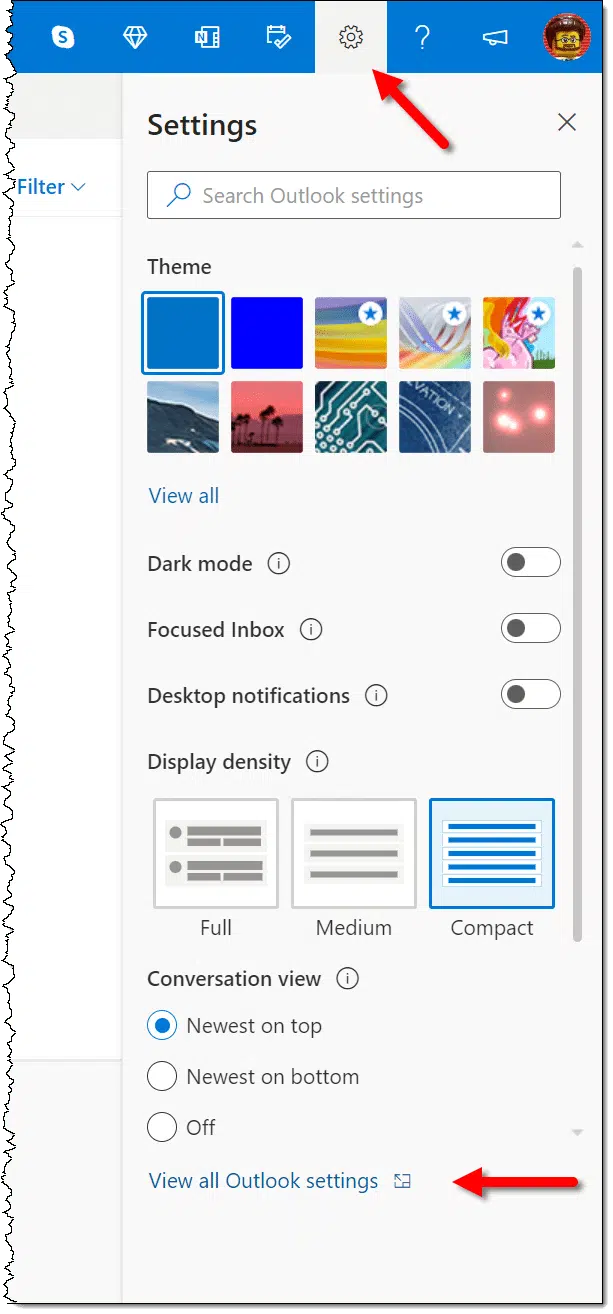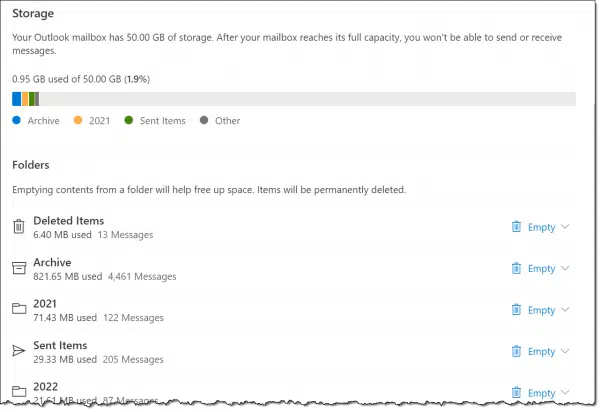(Also known as your Outlook.com or Microsoft account.)

It’s there — just well hidden. Sometimes the first you hear of it is when you get some notification that your mailbox is full.
This applies to any Microsoft account, not just Hotmail. Outlook.com and several other email services provided by Microsoft all qualify and run into similar limitations.
Let’s see how much space you have, how much you’re using, and how much is left.
Become a Patron of Ask Leo! and go ad-free!

Finding the space used in your Outlook.com account
In settings — either in “General” for free accounts, or “Premium” for Microsoft 365 subscribers — is a storage indicator. Besides showing you your total available storage and how much is used, your folders are listed from small to large so you can see which are using the most space.
Finding the space used
After you’ve signed into your Outlook.com account, click on the gear icon near the upper right and then on View all Outlook settings near the bottom of the resulting menu.

On the resulting page, if you have a Microsoft 365 subscription, click on Premium in the left-hand pane.

You may need to scroll down to find the “Storage” section.
If you have a free account, click on General in the left-hand pane and then Storage in the resulting sub-menu.

In the “Premium” example above, you can see I have 50 gigabytes of storage available to me, of which I’m currently using less than one.
Scroll down further for more information.

After the Deleted Items folder, your folders will be listed in order of size, so you can quickly determine where the space is being used.
It’s about more than the inbox
You asked specifically about the inbox, but all folders count. This includes your Inbox, Deleted Items (aka Trash/Recycle Bin), Sent Items, and any other folders you’ve created.
In my example above, you can see that my Archive folder is taking up the most space.
I could delete everything in it to free up that space, if I wanted to.
More appropriately, though, I might instead first back up that folder by using a desktop email program to connect to my Outlook.com account and download all the email using IMAP. Once on my computer, I’d copy the contents of the Archive folder to a local folder not associated with the email account. (How you do this depends on what desktop email program you use.)
Once you have things backed up, you can delete email to free up your space.
Do this
If you have a Microsoft account, know your limits. 
It’s a good idea to know how close you are to running out of space to avoid losing incoming email. If you’re close, managing the contents of your online folders using a desktop app is one good way to ensure you can keep all your mail without running out of space.
Of course, you’re backing up your email regularly anyway. Right?
Want something else in your inbox? Subscribe to Confident Computing! Less frustration and more confidence, solutions, answers, and tips every week.




Hi–In my outlook.com account, I can just click on “file” upper left and the resulting page shows all account info, including storage capacity. Clicking on “tools” on that page allows for a lot of cleanup as well. My account is old, so possibly not all are the same. Hope this helps and thanks to Leo!
I don’t know if this works with all providers, but I *just* found out that in Thunderbird, I can right-click on my inbox, select “properties”, then click “quota” to get my actual and percentage usage.
Great idea. It works on Gmail and my own domain. It doesn’t work on Yahoo Mail or my work account (I don’t believe my work account has a limit).
You can try it and see if it works on your account.
Leo, you wrote:
“…Want something else in your inbox? Subscribe to Confident Computing! Less frustration and more confidence, solutions, answers, and tips every week…”
Ah, the trademarked, copyrighted, and patented shameless self-serving Plug. I love it!* 🙂
—
*(However, you are too late: If I hadn’t already “been there, done that,” I wouldn’t even be reading this article, let alone replying to it, LOL!)
I just checked my storage. I’m using just a tad over 1/3GB out of 15, so I don’t think I’ll have to be worrying about running out of storage space any time soon. With that said, as my needs change over time, I cull my emails that I no longer need. I keep messages from friends and family ‘forever’. I keep anything related to bill payments and any other financially related email for eleven years. For any other email, on the first day of each month, as one of my monthly system maintenance routines, I review the messages I have that are more than thirty days old. If a message has nothing I need/want to keep, I delete it. If a message has anything I think is useful, I copy/edit the information I want to keep to a local txt or docx file, then delete the original email. As for backing up my email, if it resides on my PC, it gets backed up with everything else. Since I use IMAP to access my email on the server, unless I lose access to the Internet for some reason, my email store should be safe enough off premises.
Ernie
When my friend’s Hotmail account reached 95% capacity, I set up a 2nd account for him, this time with the Outlook.com domain (same user details before the @). I then had all his @hotmail.com emails forwarded automatically to the new @outlook.com address, while deleting them from the server.
This meant he did not have to advise anyone of the change, although some sharp-eyed recipients might have noticed the different domain address when they received new emails from him.
This effectively doubled his free space without a lot of hassle.
That’s a neat hack!
And anyone who hits the reply button will send the reply to the new address.
Another option is to use a desktop client like Thunderbird as an intermediary & move folders of old mail to the new account. The problem with this is the transfer process is flaky and can stop unpredictably. I once moved around 6GB to an “archive” account this way. Took forever, had to do it a folder at a time & verify the transfer for each folder…
Thanks Leo, I didn’t know how full my hotmail account was, but I do now. Bookmarked